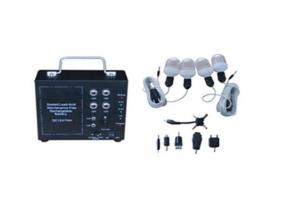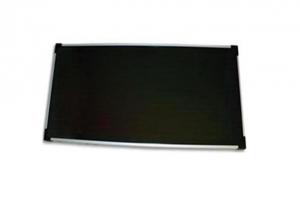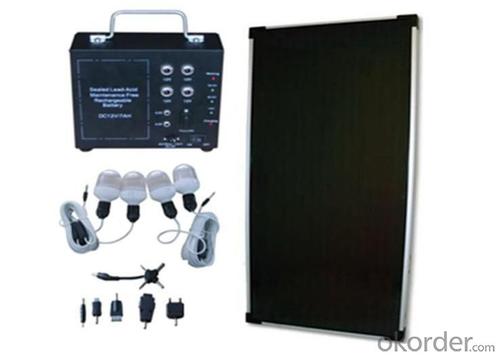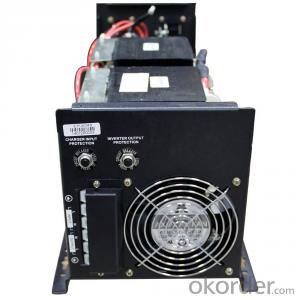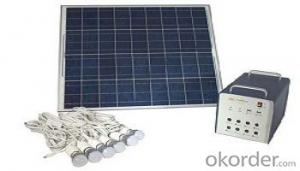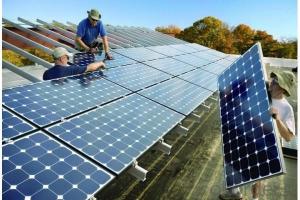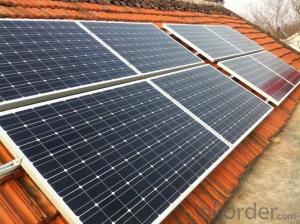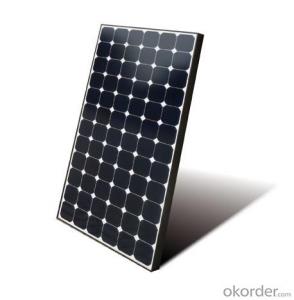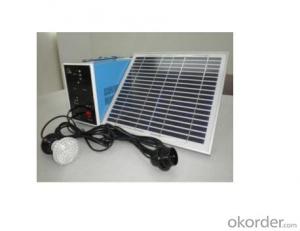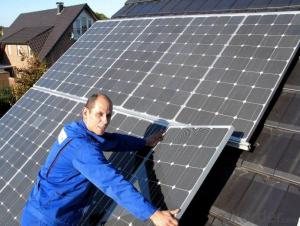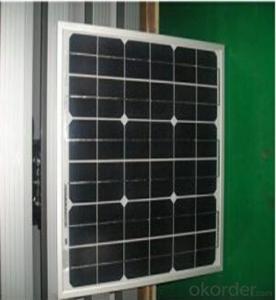Solar Energy Systems Au - CNBM-TS2 (15W)
- Loading Port:
- China Main Port
- Payment Terms:
- TT or L/C
- Min Order Qty:
- 1 set set
- Supply Capability:
- 1000 sets per month set/month
OKorder Service Pledge
OKorder Financial Service
You Might Also Like
Brief Introduction of Solar Energy System CNBM-TS2 (15W)
CNBM Solar is specialized in PV power systems 15W ourput.
Our company not only can supply high quality solar Products, but also provides professional system Solutions and high quality services.
large blocks of molten silicon carefully cooled and solidified. PolySi cells are less expensive to produce than single crystal silicon cells,
but are less efficient.
US DOE data shows that there were a higher number of multicrystalline sales than monocrystalline silicon sales.
The Sketching of Solar Energy System CNBM-TS2 (15W)
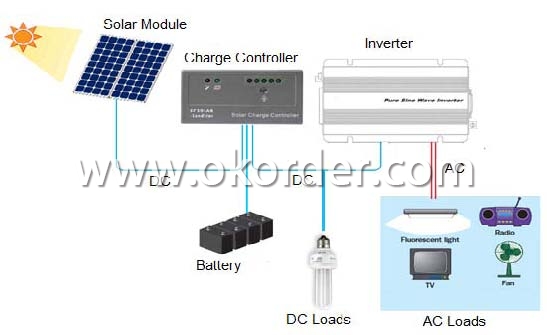
Components of Solar Energy System CNBM-TS2 (15W)
PV Array:
Convert sunlight instantly into DC electric power. Formed by the solar modules (also called photovoltaic modules) in accordance with the system requirements for series and parallel.
Solar Charge Controller:
A charge controller may be used to power DC equipment with solar panels. The charge controller provides a regulated DC output and stores excess energy in a battery as well as monitoring the battery voltage to prevent over charge or over discharge. An inverter can be connected to the output of a charge controller to drive AC loads.
Inverter:
Converts DC output power of photovaltaic soalr panels into standard AC power for use in the local off-grid electrical network. It is a critical component in a photovoltaic system, allowing the use of ordinary commercial appliances.
Battery banks:
Stores energy when there is an excess coming in and distribute it back out when there is a demand. Solar PV panels continue to re-charge batteries each day to maintain battery charge.
Technical data of Solar Home System CNBM-TS2 (15W) | ||||
Solar panel | Pmax | 15W | ||
Vmp | 17.5V | |||
Imp | 0.857A | |||
Battery | Capacity | 12V/7AH | ||
Accessories | 5W Amorphous Solar panel*1 Power box *1 LED bulb with 10m wire*4 Mobile phone adapter*1 Mounting pad*1 | |||
Package Data of Solar Home system CNBM-TS2 (15W) | ||||
Carton Size (L*W*H mm) | Carton Weight(kg) | PCS/CTN | 20’(PCS) | 40’(PCS) |
1215*185*375 | 19.8 | 2 | 600 | 1300 |
Factory Picture of Solar Energy System CNBM-TS2 (15W)
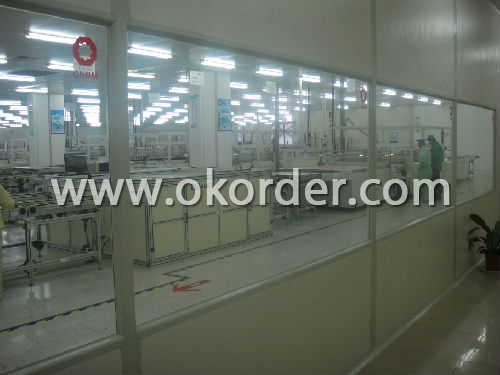
Package Picture2 of Solar Energy System CNBM-TS2 (15W)
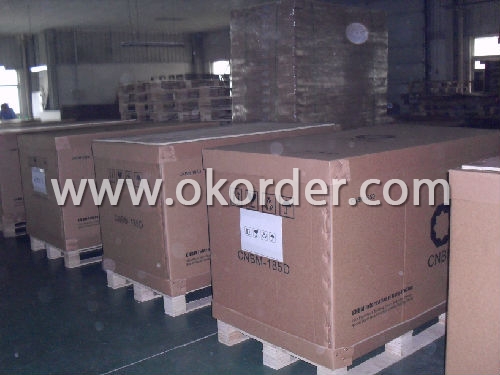
- Q: What is the lifespan of solar energy inverters?
- The lifespan of solar energy inverters typically ranges from 10 to 20 years, depending on various factors such as the quality of the inverter, usage conditions, maintenance, and technological advancements.
- Q: Can a solar energy system store excess energy for later use?
- Yes, a solar energy system can store excess energy for later use. This is achieved through the use of batteries or other storage technologies. When a solar energy system generates more electricity than is needed in real-time, the excess energy can be stored in batteries. These batteries can then be used to power the system during periods of low solar generation, such as at night or during cloudy days. By storing excess energy, solar energy systems can provide a more reliable and continuous power supply, reducing the dependence on the grid and increasing self-consumption of renewable energy.
- Q: What is the role of solar energy systems in reducing energy waste?
- Solar energy systems play a crucial role in reducing energy waste by providing a sustainable and renewable source of power. These systems harness the energy from the sun and convert it into electricity or heat, which can be used to power homes, businesses, and even entire communities. One of the main ways solar energy systems help reduce energy waste is by offsetting the need for traditional fossil fuel-based power generation. Fossil fuels, such as coal and natural gas, are finite resources that not only contribute to environmental pollution but also produce a significant amount of waste in the form of greenhouse gas emissions. By utilizing solar energy systems, we can tap into an abundant and clean energy source, thereby reducing our reliance on fossil fuels and minimizing energy waste associated with their extraction, transport, and combustion. Additionally, solar energy systems can help reduce energy waste by improving overall energy efficiency. Many solar technologies, such as photovoltaic panels and solar water heaters, are designed to directly convert sunlight into usable energy without any intermediate steps or wasteful processes. This direct conversion process eliminates the need for energy conversion losses, which are typically encountered in traditional energy generation methods. Furthermore, solar energy systems can be integrated with energy storage solutions, such as batteries, allowing excess energy produced during the day to be stored and used during periods of low sunlight, further minimizing energy waste. Moreover, solar energy systems also encourage a shift towards decentralized and distributed energy generation, reducing transmission and distribution losses. Traditional power grids often suffer from significant energy losses during long-distance transmission, with some estimates suggesting losses of up to 8% or more. By installing solar panels on rooftops or in local communities, electricity can be generated close to the point of consumption, minimizing these transmission losses and reducing overall energy waste. In summary, solar energy systems play a vital role in reducing energy waste by replacing fossil fuel-based power generation, improving energy efficiency, minimizing transmission losses, and promoting decentralized energy generation. By harnessing the power of the sun, we can transition towards a more sustainable and environmentally friendly energy future, while also reducing the overall waste associated with conventional energy sources.
- Q: Can solar energy systems be used in areas with frequent power outages?
- Yes, solar energy systems can be used in areas with frequent power outages. Solar panels generate electricity from sunlight, which means they can provide a reliable source of power even during outages. Additionally, solar energy systems can be combined with battery storage systems, allowing excess energy produced during the day to be stored and used during nighttime or when the sun is not shining. This helps ensure a continuous power supply, making solar energy a viable and sustainable solution for areas with frequent power outages.
- Q: What is the role of solar trackers in maximizing energy production?
- Solar trackers play a crucial role in maximizing energy production by optimizing the positioning of solar panels to capture the maximum amount of sunlight throughout the day. These devices automatically adjust the angle and orientation of the solar panels to track the movement of the sun, ensuring that they are always aligned at the optimal angle to receive the most sunlight. By continuously monitoring the sun's position and adjusting the panels accordingly, solar trackers significantly enhance the efficiency and energy output of solar energy systems. The main advantage of solar trackers is their ability to increase the overall energy yield of solar installations by up to 25-35% compared to fixed-tilt systems. As the sun moves across the sky, solar trackers follow its path, allowing the panels to capture sunlight from dawn to dusk, maximizing the duration of exposure to direct sunlight. This extended exposure increases the total electricity generation from the panels, making solar trackers especially beneficial in regions with varying weather patterns, seasonal changes, or areas with limited daily sunshine hours. By continuously adapting to the sun's movement, solar trackers also minimize the impact of shading. Shadows from nearby objects, such as buildings, trees, or even clouds, can significantly reduce the efficiency of solar panels. However, solar trackers can mitigate the effects of shading by adjusting the panels' positioning to avoid or minimize the shadow's impact. This ensures that the solar panels are consistently exposed to direct sunlight, maximizing the energy production potential of the entire system. Furthermore, solar trackers can contribute to reducing the payback period of solar installations. With their ability to generate more electricity, solar trackers enhance the return on investment by increasing the overall energy production and subsequently reducing the time it takes to recoup the initial costs of the system. By optimizing energy production and improving the economic viability of solar installations, solar trackers are playing a crucial role in accelerating the adoption of renewable energy and transitioning towards a sustainable future.
- Q: Can solar energy systems be used in rural areas?
- Yes, solar energy systems can definitely be used in rural areas. In fact, solar power is particularly well-suited for rural areas due to its decentralization and independence from the electrical grid. Rural areas often lack access to reliable and affordable electricity, making solar energy an attractive option. Solar panels can be installed on rooftops or on open land, providing a sustainable and renewable source of energy. Additionally, solar energy systems can be combined with energy storage solutions, such as batteries, to ensure a continuous power supply even during periods of low sunlight. This can be particularly beneficial for rural areas that may experience frequent power outages or have limited access to the electrical grid. Moreover, solar energy systems have a low maintenance requirement, making them suitable for remote locations where regular maintenance services may not be readily available. Overall, solar energy is a viable and increasingly popular solution for powering rural areas, offering numerous benefits such as reduced dependence on fossil fuels, cost savings, and environmental sustainability.
- Q: What is the role of disconnect switches in a solar energy system?
- The role of disconnect switches in a solar energy system is to ensure the safety and efficient operation of the system. These switches allow for the isolation of the solar panels or inverters from the electrical grid, providing a means to disconnect the system in case of maintenance or emergency situations. They also help in preventing electrical shocks and fires by interrupting the flow of electricity and isolating different components of the system.
- Q: Can solar energy systems be used in areas with high levels of bird activity?
- Solar energy systems can indeed be used in areas where there are many birds. However, it is crucial to take precautions in order to ensure the safety of the birds and the optimal performance of the solar panels. A common concern is the possibility of birds colliding with the panels. To address this, manufacturers often include bird deterrents such as mesh screens or reflective coatings on the panels, which make them more visible to birds and decrease the risk of collisions. Additionally, proper installation and maintenance of the solar energy systems can minimize potential nesting or roosting sites for birds, thus reducing the likelihood of damage to the panels. By addressing these considerations, it is possible to effectively utilize solar energy systems in areas with high bird activity while still protecting the local bird population.
- Q: Can solar energy systems be used for heating and cooling a home?
- Yes, solar energy systems can be used for heating and cooling a home. Solar panels can harness the sun's energy to generate electricity, which can then be used to power heating and cooling systems such as solar water heaters and air conditioners. Additionally, passive solar design principles can be incorporated into the architectural design of a home to maximize natural heating and cooling through strategic placement of windows, insulation, and thermal mass.
- Q: Can solar energy systems be installed on all types of roofs?
- Yes, solar energy systems can be installed on most types of roofs, including flat roofs, sloped roofs, and even curved roofs. However, the suitability of installation may vary depending on factors such as the roof's orientation, angle, shading, and structural integrity. It's important to consult with a professional solar installer to assess the compatibility of a specific roof for solar panel installation.
Send your message to us
Solar Energy Systems Au - CNBM-TS2 (15W)
- Loading Port:
- China Main Port
- Payment Terms:
- TT or L/C
- Min Order Qty:
- 1 set set
- Supply Capability:
- 1000 sets per month set/month
OKorder Service Pledge
OKorder Financial Service
Similar products
Hot products
Hot Searches
Related keywords

